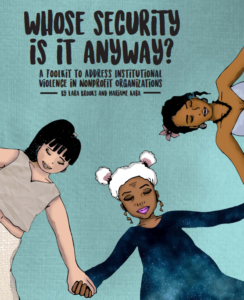Whose Security is it Anyway?
The non-profit industrial complex increasingly governs the lives of marginalized young people who are being criminalized by institutions like schools, hospitals, detention centers, and correctional facilities. Young people in group homes, at drop in centers, in homeless shelters, and recreational facilities are finding highly securitized spaces that are quick to punish and expel them. Our current social context is characterized by heightened racialized surveillance and increasing state violence particularly against people of color.
Institutional violence within community centers, healthcare organizations, and social services, in concert with the “helping” industry’s increasing collusion with and reliance on law enforcement, fuels the prison pipeline.
In response to pervasive institutional violence and increasing policing, surveillance, and targeting of queer and TGNB (trans and gender non-binary) youth of color, street-based youth, and youth experiencing homelessness, Project NIA created a toolkit to share strategies of resistance to the increased securitization of non-profit spaces. We hope our experiences, which are specific, activate organizations and the individuals working within them to reflect and take action, implementing both short- and long-term strategies to prevent, interrupt, and transform violence.
Working in collaboration with youth workers from across Chicago, this toolkit evolved from practicing violence prevention in complex spaces, youth and adult workshops, thousands of conversations, meetings convened from organizational crisis due to the impact of policing and surveillance, strategies used at the Broadway Youth Center (BYC), and research released by Young Women’s Empowerment Project (YWEP) and Project NIA.
This toolkit contains an overview of:
- The Cost of Security, Surveillance, & Policing in Youth Serving Organizations, Social Services, & Health Care
- Why Policing Fails as a Strategy to End Violence
- Intersecting Approaches to Interrupt, Prevent, & Transform Violence: Community Healing, Accountability, Capacity, & Transformation at the Broadway Youth Center
- Street Youth Rise Up Campaign: Broadway Youth Center & the Street Youth Bill of Rights
- The Case for Resource Re-Allocation: Assessing Costs, Limitations & Impact of Onsite Security
- Top Ten Ways Young People Can Reduce the Harms Committed by Security Guards
- Staff Training, Practicing, & Reflecting
Most importantly, this work is informed by the experiences of healthcare and social service consumers, patients, clients, and participants—individuals who filed grievances, reported violence to YWEP’s Bad Encounter Line, demanded better services for themselves and their communities, and organized their communities to fight back. The result is a toolkit that illuminates the need, the critical necessity, for organizations and the individuals working within them to interrogate policies and procedures with an intersectional lens, develop and learn from community accountability practices, and question program values and structures.
As organizational leaders and workers, we must understand the impact and roots of institutional violence before we can fully acknowledge the ways our programs knowingly and unknowingly, passively and actively, deny help and—on some occasions—forcefully push young people closer to engagement with law enforcement. The spectrum of social and healthcare services is wide but, at its most extreme, is comparable to a correctional facility.
The ideas offered in this toolkit are based on the belief that approaches to preventing, interrupting, and transforming violence are interconnected, mutually reinforcing, and powerfully connected to capacity, multi-threshold engagement, and authentic relationship building. We hope the strategies outlined ahead inspire, energize, and awaken possibilities towards creating more supportive, healthy and transformative spaces for young people.
To access this toolkit, complete this survey. You’ll then be able to download the toolkit.

